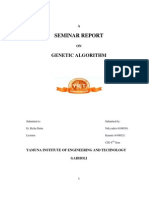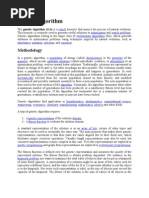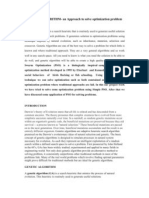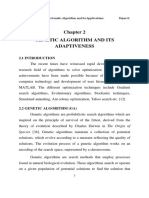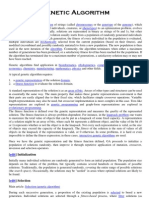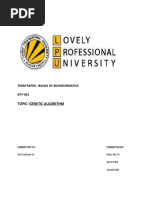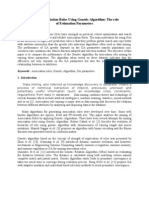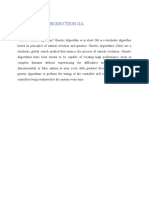unstuck-chat
unstuck-chat
Uploaded by
ramukaka777787Copyright:
Available Formats
unstuck-chat
unstuck-chat
Uploaded by
ramukaka777787Copyright
Available Formats
Share this document
Did you find this document useful?
Is this content inappropriate?
Copyright:
Available Formats
unstuck-chat
unstuck-chat
Uploaded by
ramukaka777787Copyright:
Available Formats
Summary of Genetic Algorithms in
Machine Learning
Introduction to Genetic Algorithms Genetic algorithms are heuristic search
algorithms inspired by Charles Darwin's theory of evolution. They mimic the process of
natural selection, where the fittest individuals are selected for reproduction to produce
the next generation of solutions. These algorithms are widely used in various real-world
applications, such as image processing, electronic circuit design, and artificial creativity .
Phases of Genetic Algorithms There are five main phases in a genetic algorithm:
1. Initialization: The process begins with selecting an initial population of individuals
(solutions), referred to as chromosomes. Each chromosome is characterized by
genes, which can contain binary values (0 or 1) .
2. Fitness Assignment: Each chromosome's fitness is evaluated using a fitness
function, which determines how well it solves the problem at hand .
3. Selection: The fittest individuals are selected for reproduction. Common selection
methods include relative wheel selection, tournament selection, and rank-based
selection .
4. Crossover (Reproduction): Selected individuals undergo crossover, where genes
are exchanged to create new offspring. A crossover point is identified, and genes
are swapped between parents to generate new solutions .
5. Termination: The algorithm terminates when the population converges, meaning
the new offspring are similar to existing individuals, indicating that optimal
solutions have been reached .
Mutation Occasionally, mutation is applied to introduce variability in the population.
This can involve flipping bits in the offspring's genes with a low probability, ensuring
diversity and preventing premature convergence .
Flowchart of Genetic Algorithm Process The genetic algorithm can be visualized in a
flowchart format, illustrating the iterative process of evaluating fitness, selecting
parents, applying crossover and mutation, and checking for convergence .
This structured approach allows genetic algorithms to effectively search for optimal
solutions in complex problem spaces, leveraging the principles of evolution and natural
selection.
Page 1 of 1
You might also like
- Genetic Algorithm: Review and Application: Manoj Kumar, Mohammad Husian, Naveen Upreti & Deepti GuptaDocument4 pagesGenetic Algorithm: Review and Application: Manoj Kumar, Mohammad Husian, Naveen Upreti & Deepti GuptanelsonneymanNo ratings yet
- DAA reportDocument26 pagesDAA reportMaria MalikNo ratings yet
- Genetic Algorithm ReportDocument26 pagesGenetic Algorithm ReportEr Vijeta NarwalNo ratings yet
- Wa0000.Document14 pagesWa0000.charan.s2702No ratings yet
- Genetic Algorithms: Muhannad HarrimDocument44 pagesGenetic Algorithms: Muhannad HarrimDebabrata PalNo ratings yet
- Unit 5 MLDocument48 pagesUnit 5 MLpankajjoshipj988No ratings yet
- Genetic Algo A4-1Document2 pagesGenetic Algo A4-1umartanveer113311No ratings yet
- Soft Computing ProjectDocument3 pagesSoft Computing ProjectRohan DuttaNo ratings yet
- unit-4_ML_mamDocument26 pagesunit-4_ML_mamshravyaroyy1No ratings yet
- Computational Intelligence Mid-2 notesDocument41 pagesComputational Intelligence Mid-2 notesmrdoodood13No ratings yet
- Genetic Algorithm in Machine LearningDocument6 pagesGenetic Algorithm in Machine LearningPrafull SawantNo ratings yet
- Unit-6 MlaDocument16 pagesUnit-6 Mlarobo 2.0No ratings yet
- Genetic AlgorithmDocument6 pagesGenetic AlgorithmShalinee Singh RathoreNo ratings yet
- Unit 5Document17 pagesUnit 5vijaykumargj123No ratings yet
- Unit 0.4Document13 pagesUnit 0.4harishgoyal6268518911No ratings yet
- Genetic AlgorithmDocument23 pagesGenetic Algorithmdivya2020No ratings yet
- Genetic AlgorithmDocument13 pagesGenetic AlgorithmSoumen KanrarNo ratings yet
- Genetic AlgorithmDocument18 pagesGenetic Algorithmjoshuapeter961204No ratings yet
- ML UNIT IV PART IIDocument9 pagesML UNIT IV PART IIT.Ramakrishna JITSNo ratings yet
- Bio - Inspired Class TestDocument4 pagesBio - Inspired Class TestMadheshNo ratings yet
- Genetic AlgorithmDocument40 pagesGenetic Algorithmprasang kumarNo ratings yet
- Genetic Algorithm - WikipediaDocument23 pagesGenetic Algorithm - WikipediaAnanka-Ann JongNo ratings yet
- ML Unit IVDocument27 pagesML Unit IVVasu 22No ratings yet
- Unit 3 Genetic Algorithm FinalDocument32 pagesUnit 3 Genetic Algorithm FinalDr.KalaivazhiNo ratings yet
- Genetic AlgorithmDocument13 pagesGenetic Algorithmpraveenm.phdseNo ratings yet
- SC Unit 4Document23 pagesSC Unit 4jangraradhika34No ratings yet
- Genetic AlgorithmDocument29 pagesGenetic Algorithm2K20B626 ROHIT KUMAR VERMANo ratings yet
- Mod. 3. G A ODocument8 pagesMod. 3. G A OMahesh KhadeNo ratings yet
- A Study On Genetic Algorithm and Its Applications: Related PapersDocument6 pagesA Study On Genetic Algorithm and Its Applications: Related PapersSarvagya JainNo ratings yet
- Genetic AlgorithmDocument8 pagesGenetic AlgorithmFabiano Rodrigues PereiraNo ratings yet
- Genetic AlgorithmsDocument19 pagesGenetic AlgorithmsJonecis DayapNo ratings yet
- Optimization Problems: InitializationDocument2 pagesOptimization Problems: InitializationedonaNo ratings yet
- Unit 2, 4,5,3 SCDocument23 pagesUnit 2, 4,5,3 SC2313323037015No ratings yet
- UNIT 4 DA 15 markDocument3 pagesUNIT 4 DA 15 markklncse2025No ratings yet
- 09 Chapter2 PDFDocument23 pages09 Chapter2 PDFAjay SenNo ratings yet
- AIOT-UNIT 3Document13 pagesAIOT-UNIT 3santhosh sekarNo ratings yet
- Genetic AlgorithmsDocument3 pagesGenetic Algorithmsjayantimisra36No ratings yet
- Chapter 4 - GADocument73 pagesChapter 4 - GAMohammed A. Al SattariNo ratings yet
- Genetic AlgorithmDocument22 pagesGenetic Algorithmdilipy20022No ratings yet
- Genetic Algorithm: InitializationDocument6 pagesGenetic Algorithm: InitializationRavindra VankinaNo ratings yet
- Genetic Algorithm L9Document6 pagesGenetic Algorithm L9Pravesh SrivastavaNo ratings yet
- A Study On Genetic Algorithm and Its AppDocument5 pagesA Study On Genetic Algorithm and Its AppHuu Le PhuocNo ratings yet
- Evolutionary Algorithms: Asst. Prof. Dr. Mohammed Najm AbdullahDocument58 pagesEvolutionary Algorithms: Asst. Prof. Dr. Mohammed Najm AbdullahMuhanad Al-khalisyNo ratings yet
- Genetic AlgorithmDocument8 pagesGenetic AlgorithmparostdevilNo ratings yet
- Genetic Algorithms: Department of Information Technology University of The Punjab, Jhelum CampusDocument12 pagesGenetic Algorithms: Department of Information Technology University of The Punjab, Jhelum CampusMalik AwanNo ratings yet
- Genetic Algorithms 1Document39 pagesGenetic Algorithms 1jeysamNo ratings yet
- BTech 2024 ML Genetic AlgorithmsDocument40 pagesBTech 2024 ML Genetic AlgorithmsmeghNo ratings yet
- The Implementation of Simple Genetic Algorithm in A Simple Card Dividing GameDocument8 pagesThe Implementation of Simple Genetic Algorithm in A Simple Card Dividing GameChristopher AndrewNo ratings yet
- Genetic AlgorithmDocument29 pagesGenetic AlgorithmRUKESH KNo ratings yet
- (Peter Leow) Genetic Algorithms Demystified UnravDocument58 pages(Peter Leow) Genetic Algorithms Demystified Unravasdsad123mNo ratings yet
- Topic: Genetic Algorithm: Term Paper: Basics of Bioinformatics BTY-301Document17 pagesTopic: Genetic Algorithm: Term Paper: Basics of Bioinformatics BTY-301Junaid NabiNo ratings yet
- Mining Association Rules Using Genetic Algorithm: The Role of Estimation ParametersDocument9 pagesMining Association Rules Using Genetic Algorithm: The Role of Estimation ParametersindirasivakumarNo ratings yet
- 4.1 Genetic AlgorithmsDocument25 pages4.1 Genetic Algorithmsmravali262003No ratings yet
- Bioinspired Algorithms and ApplicationsDocument42 pagesBioinspired Algorithms and ApplicationsAdvith A JNo ratings yet
- An Overview of Genetic Algorithms A Structural AnalysisDocument5 pagesAn Overview of Genetic Algorithms A Structural AnalysisInternational Journal of Innovative Science and Research TechnologyNo ratings yet
- Chapter 3: Introduction Ga: I. ObjectiveDocument8 pagesChapter 3: Introduction Ga: I. ObjectiveHoang Dung SonNo ratings yet


